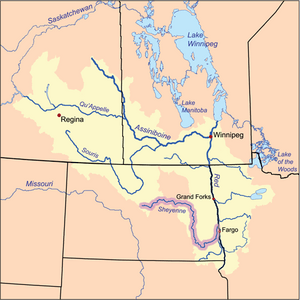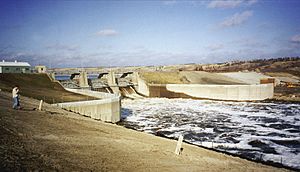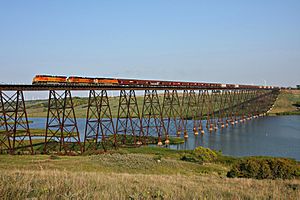Sheyenne River facts for kids
The Sheyenne River is a very important river in eastern North Dakota, United States. It is one of the main rivers that flows into the Red River of the North. The Sheyenne River twists and turns for about 591 miles (951 km) across the state.
Contents
The River's Journey
The Sheyenne River starts about 15 miles (24 km) north of McClusky. It first flows east, then turns south near McVille. The river continues south through Griggs and Barnes counties. Near Lisbon, it turns and flows northeast.
Lake Ashtabula and Baldhill Dam
A large part of the river forms Lake Ashtabula. This lake is 27 miles (43 km) long. It was created by the Baldhill Dam, which is north of Valley City. The dam was built in 1951 by the U.S. Army Corps of Engineers. Its main job is to help control floods.
A River with High Banks
The Sheyenne River is special because it is a "perch river." This means its banks are higher than the land around it. These high banks formed naturally over centuries during floods. They are like natural walls. When the river floods and breaks through these banks, the water can spread out over a very wide area.
Flowing Through Different Lands
From Lisbon, the river flows through the Sheyenne National Grassland. It then enters Cass County near Kindred. This part of the river is special and is called a National Wild and Scenic Riverway.
Into the Red River Valley
After Kindred, the river flows north and northeast. It goes through the rich, flat lands of the Red River Valley. The river changes here. It leaves the sandy grasslands and picks up the fertile clay soil of the valley.
Protecting Cities from Floods
In the past, the Sheyenne River caused big floods in cities like West Fargo and Harwood. The river joins the Red River of the North at Harwood. The Red River then flows north to Lake Winnipeg in Manitoba, Canada.
Thanks to a special canal, these cities are now much safer from floods. This canal was finished near Horace and goes past West Fargo. It helped a lot during the big 1997 Red River flood. While that flood caused a lot of damage in Grand Forks and East Grand Forks, the Sheyenne River cities were much better off.
The Sheyenne Diversion Canal
The Sheyenne diversion canal was built between 1990 and 1992. It was a team effort between the government and the state. The canal helps move floodwaters around the edges of cities. This stops the water from flooding homes and businesses. The U.S. Army Corps of Engineers built most of it. It cost about $27.8 million.
In West Fargo alone, this project included:
- A 6.8-mile (10.9 km) long diversion control channel.
- 12.7 miles (20.4 km) of protective walls called levees.
- Four structures to control where the water goes.
- Two pumping stations to move water away.
- One new railroad bridge.
- Four new highway bridges.
- Six places where roads were raised higher.
River's Name Origin
The Sheyenne River was named after the Cheyenne Native American people who lived in the area. Other names for the river include Cayenne River, Cheyenne River, and Maitomoni'ohe.
Bridges Crossing the Sheyenne
Many bridges cross the Sheyenne River. Some of these are very old and important. They include the Lisbon Bridge and the Colton's Crossing Bridge in Lisbon. The West Park Bridge is in Valley City. The West Antelope Bridge is near Flora. You can also find the Romness Bridge near Cooperstown and the Nesheim Bridge at McVille.
In Valley City, several other bridges cross the river, including the Hi-Line Railroad Bridge.
See also
 In Spanish: Río Sheyenne para niños
In Spanish: Río Sheyenne para niños




